
Mortehoe and Woolacombe railway station was a station on the London and South Western Railway Ilfracombe Branch Line between Barnstaple and Ilfracombe in North Devon, England (grid reference SS483438 ).

Mortehoe and Woolacombe railway station was a station on the London and South Western Railway Ilfracombe Branch Line between Barnstaple and Ilfracombe in North Devon, England (grid reference SS483438 ).
The station was opened in 1874, with the line, and served the villages of Mortehoe and Woolacombe. It was known as Morthoe until 13 May 1902. The station was the location of eminent railway photographer Ivo Peters's first steam train photograph in 1925; [1] and was immortalised in 1964 in the song Slow Train by Flanders and Swann. It was closed to passengers in October 1970 when the branch closed.

After lying semi-derelict for many years, in the early 1990s the station was used as the basis for a children's theme park called Once Upon a Time. Four redundant British Railways Mark 1 coaches were craned into position between the platforms, and a number of ex-BR 4-wheel vans (mostly 12-ton "Vanwide" type) were located around the grounds. The former rolling stock was used to contain fairytale animations, while the rest of the station and area around it were used to hold small children's rides. Although opened independently, the attraction was latterly owned by the operators of nearby Watermouth Castle. In 2004, the attraction was sold when the owner was approached by a housing developer. Although the first offer of £500,000 was refused, the developer put in a later offer of £800,000 which was accepted, [2] and the attraction closed at the end of the 2005 season. [3]
In December 2006, a planning application was lodged for the redevelopment of the site. [4] The plan covered the building of seven units of affordable housing, located in the area currently occupied by the platforms, and 37 units of ("temporary") holiday accommodation, the latter to be known as the Atlantic Lodge Holiday Park, and due to be available from 1 May 2009. [5] The surviving station buildings, including the signal box, would be retained, converted to form a reception area, offices and shop for the holiday accommodation. The design of the houses was intended to be sympathetic to the station building, following the same roofline and using similar building materials. The Tarka Trail would continue to skirt the eastern edge of the site. The planning application consultation period was expected to be completed in April 2007.
By August 2007, all of the external amusement rides and constructions had been auctioned off or demolished, leaving just the main buildings and platforms intact.
By May 2013 the site had been largely completed, with a mixture of permanent and holiday homes. The builder's website showing the completed homes and plans for a third phase. [6]
In late 2015 a charity named Combe Rail was formed with the intention of establishing a heritage railway on the trackbed of the Ilfracombe-Barnstaple line as well as lobbying for a full reopening in the future. [7]

Ilfracombe is a seaside resort and civil parish on the North Devon coast, England, with a small harbour surrounded by cliffs.

North Devon is a local government district in Devon, England. Its council is based just outside Barnstaple, the district's largest town. The district also includes the towns of Ilfracombe, Lynton and Lynmouth and South Molton along with numerous villages and surrounding rural areas.

Croyde is a village on the west-facing coastline of North Devon, England. The village lies on the South West Coast Path near to Baggy Point, which is owned by the National Trust. It lies within the North Devon Coast Area of Outstanding Natural Beauty.
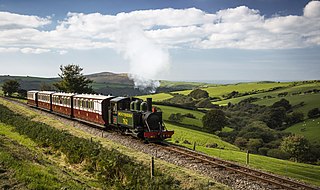
The Lynton and Barnstaple Railway (L&B) opened as an independent railway in May 1898. It was a single track, 1 ft 11+1⁄2 in narrow gauge railway and was slightly over 19 miles (31 km) long running through the rugged and picturesque area bordering Exmoor in North Devon, England. Although opened after the Light Railways Act 1896 came into force, it was authorised and constructed prior to that act. Therefore, as with all other railways, it was authorised under its own Act of Parliament and built to higher standards than similar railways of the time. In the United Kingdom it was notable as being the only narrow gauge line required to use main-line standard signalling. For a short period the line earned a modest return for shareholders, but for most of its life the L&B made a loss. In 1923, the L&B was taken over by the Southern Railway, and eventually closed in September 1935.
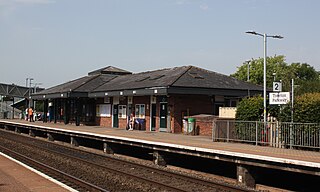
Tiverton Parkway railway station is on the Bristol to Exeter line in Devon, England. Despite being named after the town of Tiverton, it is actually located in the village of Burlescombe, near Sampford Peverell, 6 miles (9.7 km) to the east of Tiverton, and close to the junction of the M5 motorway with the A361 North Devon link road. It is 177 miles 28 chains from the zero point at London Paddington via Bristol Temple Meads.
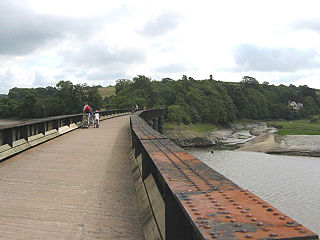
The Tarka Trail is a series of footpaths and cyclepaths around north Devon, England that follow the route taken by the fictional Tarka the Otter in the book of that name. It covers a total of 180 miles (290 km) in a figure-of-eight route, centred on Barnstaple.

Woolacombe is a seaside resort on the coast of North Devon, England, which lies at the mouth of a valley in the parish of Mortehoe. The beach is 2 miles (3.2 km) long, sandy, gently sloping and faces the Atlantic Ocean near the western limit of the Bristol Channel.

Mortehoe is a village and former manor on the north coast of Devon, England. It lies 10 miles north-west of Barnstaple, near Woolacombe and Lee Bay, and is sited in a valley within the hilly sand-dune-like land behind Morte Point, almost directly above Woolacombe. The parish population at the 2011 census was 1,637.
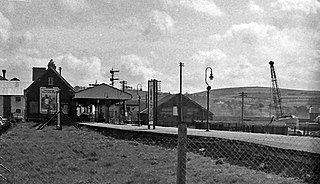
Barnstaple Town railway station was an intermediate station on the L&SWR line to Ilfracombe, England.
Pilton Yard, in Barnstaple was, between 1898 and 1935, the main depot and operating centre of the Lynton and Barnstaple Railway ('L&B'), a narrow gauge line that ran through Exmoor from Barnstaple to Lynton and Lynmouth in north Devon, England. Pilton station was served by regular passenger services advertised between 1898 and 1904 after which only goods facilities were provided. Passengers were catered for at the nearby LSWR station, Barnstaple Town, which provided connections with trains on the standard gauge branch line to Ilfracombe. The L&B's main offices were also based at Pilton, in a building formerly belonging to the Tannery which had earlier occupied the site, and which took over the site after the railway closed.

Eggesford railway station is a rural station in Devon, England, serving Eggesford, the town of Chulmleigh and surrounding villages. Despite its name, the station is in the neighbouring civil parish of Chawleigh. It is on the Tarka Line to Barnstaple, 22 miles 27 chains (35.9 km) from Exeter Central at milepost 193.75 from London Waterloo.
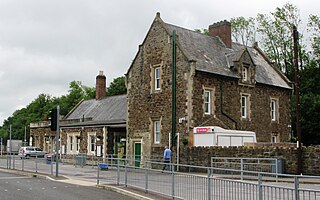
Barnstaple railway station is the northern terminus of the Tarka Line and serves the town of Barnstaple, Devon. It is 39 miles 75 chains (64.3 km) from Exeter Central and 211.25 miles (339.97 km) from London Waterloo. It is managed by Great Western Railway, which also operates the passenger service.
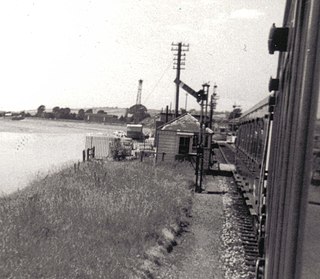
Barnstaple Quay was an intermediate station on the L&SWR line to Ilfracombe in Devon, England. The station opened in 1874, and located on the north bank of the River Taw close to the centre of Barnstaple, was renamed Barnstaple Town in 1886. With the opening of the Lynton and Barnstaple Railway in 1898, the station was relocated to its present site, to accommodate passenger exchange to the narrow gauge line. The station became the town's bus station, but this closed in 1999 and the building then became a café when a new and larger bus station was opened closer to the town centre.
The North Devon Railway connected Barnstaple to the growing railway network in 1854 and as Ilfracombe developed as a watering place, it was obvious a railway connection to the town was needed. The hilly terrain was very difficult, but an Ilfracombe Railway was authorised in 1864 but failed when a major shareholder was unable to respond to a subscription call. After several false starts the Barnstaple and Ilfracombe Railway, soon taken over by the London and South Western Railway, opened in 1870.
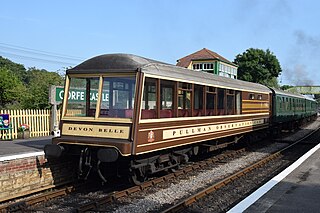
The Devon Belle was a luxury express passenger train in England which ran between London Waterloo station and Ilfracombe and Plymouth in Devon in the years from 1947 to 1954.

The Devon and Somerset Railway (D&SR) was a cross-country line that connected Barnstaple in Devon, England, to the network of the Bristol and Exeter Railway (B&ER) near Taunton. It was opened in stages between 1871 and 1873 and closed in 1966. It served a mostly rural area although it carried some through services from east of Taunton to the seaside resort of Ilfracombe.
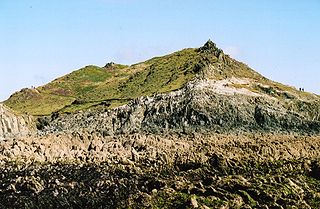
Morte Point is a peninsula on the north west coast of Devon, England, belonging to the National Trust. To the east is the village of Mortehoe and to the south is the seaside resort of Woolacombe.

Barnstaple railway station was the western terminus of the Devon and Somerset Railway. It was situated on the south eastern side of Barnstaple in Devon, England. It was served by passenger trains from 1873 until 1960, and by freight trains until 1970.

The Devon Coast to Coast Cycle Route is a 99-mile waymarked route from Ilfracombe in north Devon to Plymouth in south Devon. It skirts the National Parks of both Exmoor and Dartmoor and incorporates part of the Tarka Trail in the north, The Granite Way from Okehampton to Lydford and Drake's Trail from Tavistock to Plymouth.
| Preceding station | Disused railways | Following station | ||
|---|---|---|---|---|
| Braunton Line and station closed | London and South Western Railway Barnstaple and Ilfracombe Railway | Ilfracombe Line and station closed |